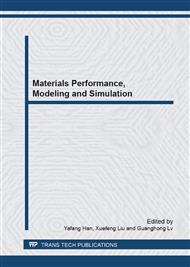[1]
Q. Sun, J. Lu, L. Jin, et al., Study on mechanical properties of Ti stabilized ultra low carbon sheet steel, Iron and Steel. 35 (2000) 39-42.
Google Scholar
[2]
Q. Sun, X. Wang, Effect of RE, Ti and Nb on properties of ULC cold-rolled steel sheets for enameling use, Iron and Steel. 39 (2004) 59-62.
Google Scholar
[3]
X. Ren, W. Chu, J. Li, et al., Effect of MnS inclusions on hydrogen diffusion in steel, Journal of University of Science and Technology Beijing. 29 (2007) 232-236.
Google Scholar
[4]
T. Otsuka, T. Tanabe, Hydrogen diffusion and trapping process around MnS precipitates in alpha Fe examined by tritium autoradiography, Journal of Alloys and Compounds. 446 (2007) 655-659.
DOI: 10.1016/j.jallcom.2007.02.005
Google Scholar
[5]
J. Shinozaki, I. Muto, T. Omura, et al., Local dissolution of MnS inclusion and microstructural distribution of absorbed hydrogen in carbon steel, Journal of The Electrochemical Society. 158 (2011) C302-C309.
DOI: 10.1149/1.3611405
Google Scholar
[6]
W.C. Luu, J.K. Wu, Effects of sulfide inclusion on hydrogen transport in steels, Materials Letters. 24 (1995) 175-179.
DOI: 10.1016/0167-577x(95)00068-2
Google Scholar
[7]
K.C. Chou, Z. Szklarska-Smialowska, Comparison of the behavior of hydrogen in two carbon steels differing in sulfur content, Corrosion. 46 (1990) 118.
DOI: 10.5006/1.3585075
Google Scholar
[8]
M. Iino, Trapping of hydrogen by sulfur associated defects in steel, Metallurgical and Materials Transactions A. 16 (1985) 401-409.
DOI: 10.1007/bf02814338
Google Scholar
[9]
M. Garet, A.M. Brass, C. Haut, et al., Hydrogen trapping on non metallic inclusions in Cr-Mo low alloy steels, Corrosion Science. 40 (1998) 1073-1086.
DOI: 10.1016/s0010-938x(98)00008-0
Google Scholar
[10]
P.H. Pumphrey, The role of sulfide inclusions in hydrogen entry during the exposure of steels to acids, Corrosion. 36 (1980) 537-543.
DOI: 10.5006/0010-9312-36.10.537
Google Scholar
[11]
MAV Devanathan, Z. Stachurki, The Adsorption and Diffusion of Electrolytic Hydrogen in Palladium. Proc. R. Soc. A. 270 (1962) 90.
Google Scholar
[12]
R. Nishimura, K. Toba, K. Yamakawa, The development of a ceramic sensor for the prediction of hydrogen attack, Corrosion science. 38 (1996) 611.
DOI: 10.1016/0010-938x(95)00150-i
Google Scholar
[13]
K. Chang, J.H. Kwak, Effect of Manganese on Aging in Low Carbon Sheet Steels, ISIJ Int. 37 (1997) 74.
DOI: 10.2355/isijinternational.37.74
Google Scholar
[14]
K. Ushioda, N. Yoshinaga, O. Akasue, Influences of Mn on Recrystallization Behavior and Annealing Texture Formation in Ultralow-carbon and Low-carbon Steels, ISIJ International. 34 (1994) 85-91.
DOI: 10.2355/isijinternational.34.85
Google Scholar
[15]
J.F. Held. In: Proceedings of the conference on mechanical working and steel processing IV. New York (NY), Metallurgical Society of AIME, (1965).
Google Scholar
[16]
W. Chen, W. Tong, H. Zhang, et al., Texture evolution and growth of differently sized grains in IF steel during annealing, Acta Metallurgica Sinica. 46 (2010) 1055-1060.
DOI: 10.3724/sp.j.1037.2010.00198
Google Scholar


